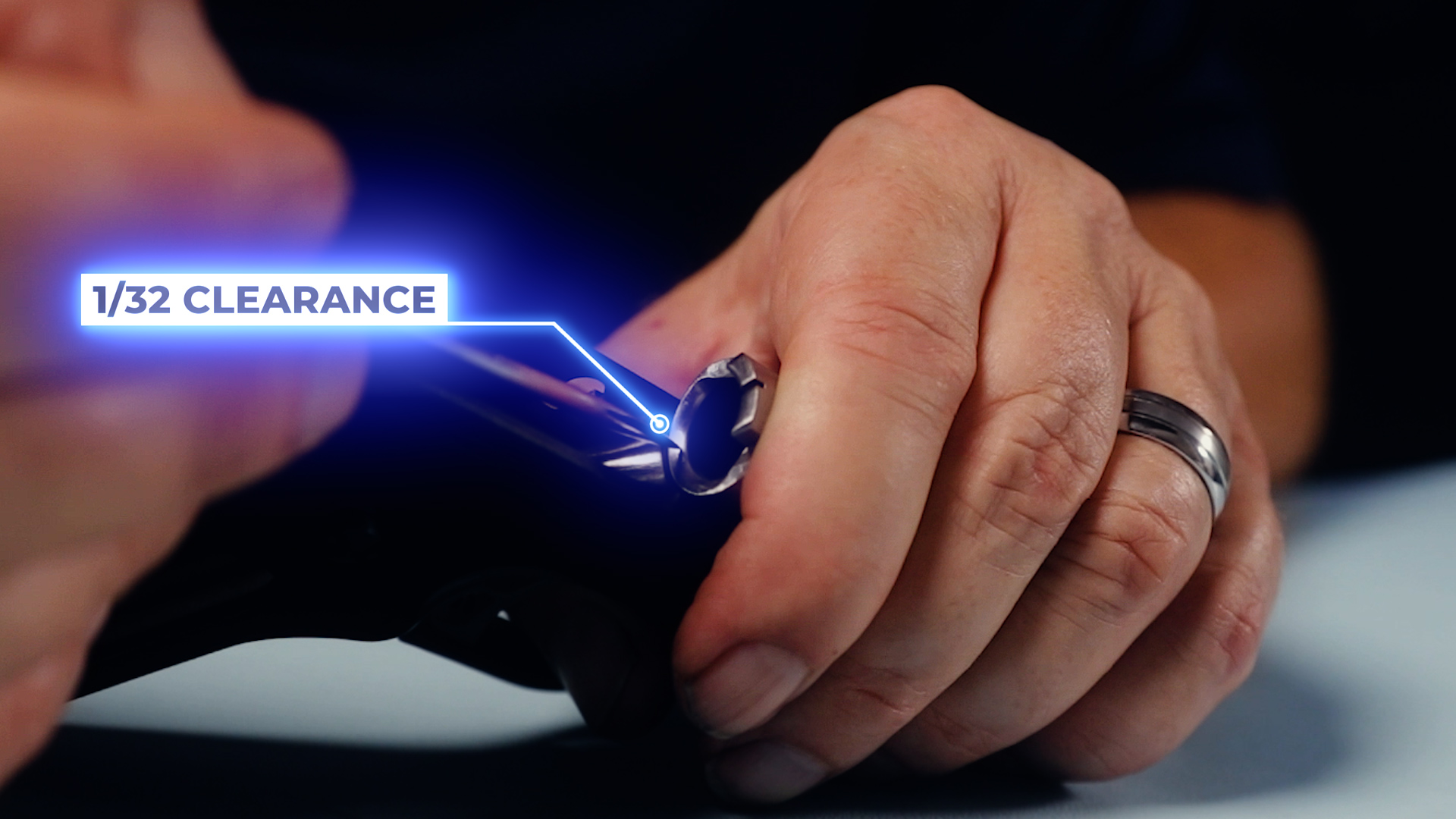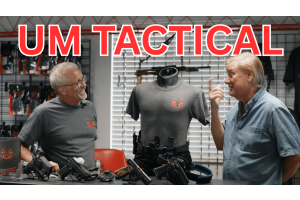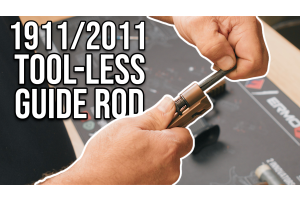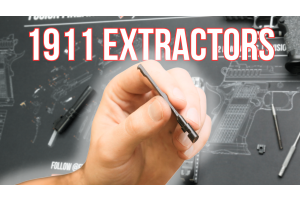1911 Feeding (Ep. 2) | Barrel Throating | Feed Ramp Clearance
0%

In this video we will go over the process that involves proper feeding from the feed ramp into the barrel throat. This is a Critical step and involves some hand skills but with attention to detail and a little time this video should help you solve this issue. Thanks for watching and as always have a great day from the Fusion Firearms Family!!!
CHECK OUT OUR MINDS CHANNEL: https://www.minds.com/fusion_firearms/
CHECK US OUT ON FACEBOOK!
Facebook Tech: https://www.facebook.com/Bobs1911bench
Facebook Info: https://www.facebook.com/FusionFirearms
CHECK OUT OUR INSTAGRAM: https://www.instagram.com/fusionfirea...
Music: https://artlist.io/
Solving Feeding Issues In A 1911:
The Importance of the 32nd of an Inch
If you own a 1911 pistol, you may have experienced feeding issues. These issues can often be addressed by ensuring that your barrel is properly fitted. This is especially important for standard barrels, rather than ramp barrels. One key factor in fitting your 1911 barrel is the "32nd of an inch," which refers to the gap between the frame feed ramp and the barrel throat. This gap should be approximately 1/32nd of an inch, or 30 thousandths, in order to ensure proper feeding.
To achieve this gap, you may need to grind or file down the barrel throat to achieve the desired fit. It's important to note that this measurement is a general rule and may need to be adjusted depending on the type of ammunition you are using. If you are using special reloads with unique bullet geometries, for example, you may need to alter the barrel throat or feed ramp to accommodate these rounds.
It's also important to consider the purpose of your 1911. If you are using it for recreational shooting or target practice, you will generally want to minimize the amount of barrel throating. On the other hand, if you are using specific hollow points or other types of ammunition, you may need to modify the feed ramp or throat to better fit these rounds.
Overall, the key to addressing feeding issues in a 1911 is to ensure that the gap between the frame feed ramp and barrel throat is properly fitted. By following these guidelines, you can improve the reliability and performance of your 1911 pistol.
FULL TRANSCRIPT
HI folks today we are going to continue the feeding Issues In a 1911 and some of the Items that we see all the time and how do we address those Items this one I call It you know the ever Important 32nd of an Inch. okay and what do I mean by that well and again this only applies to standard barrels It really doesn't apply to ramp barrel so If you have a you have a Para/Clark ramp barrel or a or a Wilson /Nolan style ramp barrel this won't really apply but for all your standard barrels out there this Is pretty much a general rule when you're fitting you 1911 barrel and you want to ensure that you're going to have some pretty decent feeding. This will also really be dependent on your ammunition. This Is an overall general rule you may have to you may have to deviate with that depending on your ammo. If you have some special reloads that have different bullet geometries, trying to tune a pistol without just blowing the throat out to feed everything under the sun Is difficult. Some people say well my Glock does! Yes, it does but if you look at the brass It is all blown out in the bottom. I mean you cannot even reuse the brass because it is blown out so much and that is how they get It to do that Is because they just set up everything for a defensive purpose. When we look at our 1911s, we look at recreational and we look at target purposes. Which again you generally look at you look at a minim of barrel throating and then If you want to go with other type of hollow points or things of that nature “specific ammos” then we'd end up changing the barrel throat, extending the ramp a little bit feed ramp to compensate or tailor that 1911 around those rounds. Now you know that gets specific but again that is really for a small group of people who have specific loads. They could be shooting bullseye or shooting some specific cast bullet they like or some specific hollow point. In this case you will need to throat the barrel to fit their needs.For general purpose ball ammo for recreational shooting this will really work for most people so what are we going to what Is that 1/32nd well and again the only way to really show Is with the slide locked up and everything but for video purposes and that we're goanna do It In this fashion generally what I'll do Is you know I'll open the gun and I can actually look down inside the slide that 1/32nd of an Inch Is at the when you look at the tangent point from the end of the feed ramp on the frame and then you got the barrel throat here okay which Is actually you know If you want to call It the contingent barrel feed ramp going Into the throat or Into the chamber you know you want a gap generally there of approximately 1 32nd of an Inch okay about 30 pounds okay so here we'll see we're going to examine that 32nd of an Inch you have the frame feed ramp here that you'll see that I polished you'll see the barrel throat feed ramp on the barrel or throating area I call It the throat and you'll also see you'll basically have almost negative you're almost overlapping the feed ramp on the frame so you're goanna have a stub point right In this area so again that that 1/32nd of an Inch or 30 thousandths Is going to be from this tangent point of the center line of the frame where you come up off the feed ramp and then the frame feed ramp to the barrel throat. You're going to grind the barrel back file It back and then redo this throated area of the barrel so you have 1/32nd of an inch from the frame feed ramp to the barrel throat. That one thirty second Is kind of discretionary and It's going to be an eyeball so when I have this barrel and this frame then this is made for examples for you to see what's really going on here and then we'll go out and cut the barrel back slightly.I'll show you what I mean by that all right so here's an example of one I've cut back and you'll see where I have this marked up in red. I've cut It back on an angle going down toward the barrel feet here. I know a lot of people are going to say “Bob what's the exact angle?” This is somewhat discretionary because how do we know when we look at all the different manufacturers out there and guns that are used as somebody's been playing width the feed ramp you know there's so many variables from where your feed ramp is In the gun. where the you know your link pine Is In the you know the link pin the actual slide stop pink Is going to go Into your frame there's all these variables how deep your barrel bed Is caught you know there's all these different variables that are going to change that angle sightly generally this angle when I check them It's generally around five to seven degrees okay but again that's not gospel you're goanna you're goanna take this and cut this back and you'll see how I cut It back and again how you're going to do that you can If you have good hand skills you can use a belt sander If you have I want to take your time a little bit more you can use a file and just file flat file you can use any type of decent flat file a bastard file you know and take It on an angle until you achieve that and you can just keep take a little bit off take It put It back In your frame see how close you're becoming to the 1/32nd of an Inch but you wills see the tangent point of thins angle again the angle Is going to start down here at the at the throat of the barrel okay but you'll notice I have a quite a big flat now on the throat of this barrel down here because again I picked this barrel this frame combination all this so It would show you the extremes of what's really going on here so that you know you can really get an Idea of how to do this you'll also notice when I cut this angle I you'll see that I call this a smile face. It's actually the throat area of the barrel here and I usually use that as a guide on both sides as a tangent point to file back I start there and file down and usually I don't try to overlap my angle this tangent point any further than where that that smileys face ends right here somewhere In that area and again that's discretionary you know when you look at how a bullet feeds your you know all your all your money for feeding a bullet Is going to be down In this area here feed ramp or the throat of the barrel the feed ramp on the frame you know all those Items It's not going to have a whole lot to do width what's going on up here unless you have like burs In the chamber or something like that you know the bullet nose and bullet geometry Is goanna have all Its Impact and you know need working down In this area here so again that's just something to think about and I usually don't like to ruin any of the contact points up here If somebody wants to contact the barrel there so on the slide so again If I look straight across here at that smiley face that I call where the barrel throat Is that's where I have a tangent point and then down to the bottom and that wills make up our 330 or 132nd of an Inch thirty thousand okay now you can see here we have the same feed ramp on the frame we haven't changed this at all we have cut back where this red area Is here Is on the barrel we've cut that back on an approximately five to seven degree angle and now you'll see that the from the back of the barrel to the tangent point of the frame feed ramp and the barrel bed right here on the center line of the frame you'll see we have approximately 1 32nd of an Inch and again that's kind of an eyeball method you can measure It width a feeler gauge or something of that nature If you wish but approximately you know 25 to 32 35 000 you're usually In good shape right there then the next we'll have to do Is go back In here and redo the barrel throat Itself because obviously your bullet nose Is not going to feed on hitting this flat right here [Moosic] okay now you can see that our throat Is finished we've conditioned the throat now you may have to condition this a few times basically this Is part of the tuning your pistol for feeding properly and you're going to want to reassemble the entire pistol with the slide of course all the parts go out and test fired and just see how your ammo Is feeding If you're still having some Issues you know you can look at pushing In slightly this area here the barrel throw or put a slight radius you'll see I put a slight radius on that barrel throat right there which actually helps with Feeding so you'll see In the In the video also that we use a series on a Fordham you know Fordham sander or Dremel style tool we use a Series of different sanding dry those sanding dress you'll also notice that I'm right-handed I'll be holding the tool the actual moto tool ford ham tool whatever you want to call It the rotary tool I'll be holding my right hand and I'll be oscillating the barrel like this width my left hand back and forth to get a nice consistent smooth angle and you can see If you've got good hand skills It comes out really nice now yes I know there's fixtures for this when we make our production match barrels and that obviously we're doing them on a conk and things of that nature but again at home how are you going to do this and how you're going to fix this at home how are you going to Improve your feeding and this Is the simples and best way when you start doing tuning It It's going to be mostly hand work and you can do a very nice job and we'll move from different sanding dry down to a you know a felt bob width some polishing compound and then blend It In from there but you'll see how we have a nice angle on the feed ramp of the barrel If you want to call It and then on the on the throat of the barrel we have a nice little radius right here now again you want to use your own discretion you can't push this angle back too far you'll lose case support you know but you got to remember the web of the of all the cases the web of the brass Is made to handle you know like 20 25 In max of the general spin for a standard load so you're not you should not have any bulge cases you should not have with standard loads you should not have any you know blown cases or anything of that nature this Is pretty much a basic gunsmithing skill that you know you want to learn on a 1911 or several you know any others Is the barrel conditioning Is very Important so we also on our website we do have the sanding rd. kits which comes with a bunch of the little sanding and one of the one of the arbors so you can actually do this when we also have the felt bobs and that In stock here for people that we use all the time okay again here we have our finished barrel throat and feed ramp so again we have a polished feed ramp on the frame the tangent point goes up to the barrel bed the barrel bed to the bottom of the barrel throat If you want to call It Is about 1 32 of an Inch and then we have our conditioned barrel throat for proper feeding and again this angle you know you might want to Increase the angle on the barrel throat depending on your bullet geometry a little bit or add a little bit more radius right here on the on the barrel throat right In this area and again that wills be where you start at the minim and then you go out and test fire width your loads see how everything’s feeding see how you like It and maybe you don't need any more barrel throating If you're still having Issues then you know go ahead and look at maybe adding a little bit more barrel throating but again before you start working the barrel throat to any type of excessive means make sure that your feeding Issue Isn't from something else It Isn't from the mag It Isn't from the bot you know your bullet case Is hitting the bottom of the ejector you know the angles on the back of the barrel the extractor tension again these will be all things that we'll be getting Into as we roll Into the more of the videos on things that affect your feeding In the 1911. If you have any questions you know, put them below in the comments or give us a holler, put an email through our tech help at fusIonfIrearms.com and we really appreciate you watching and the channel's growing great and we really thank you all for sticking width us thank you very much.






